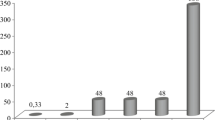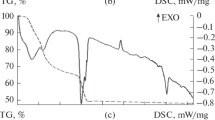Glass-ceramic based on compositions in the system Sr(Ba)–Al2O3–SiO2, modified by additions of zirconium oxide ZrO2 and hafnium oxide HfO2 with and without yttrium as a stabilizer, was synthesized by the sol-gel method. It was shown that the introduction of refractory oxides shortens the gelation time of the initial solutions, intensifies the sintering of the glass-ceramic, and changes the temperature intervals of phase formation processes and the nature of the precipitated crystalline phases. The sol-gel method made it possible to obtain a uniform distribution of the modifier-oxide grains in the bulk of the glass-ceramic. The yttrium oxide in the structure of the materials is concentrated near ZrO2 and HfO2 particles.





Similar content being viewed by others
References
G. H. Beall, “Refractory glass-ceramics based on alkaline earth aluminosilicates,” J. Europ. Ceram. Soc., No. 29, 1211 – 1219 (2009).
Y. M. Sung and S. Kim, “Sintering and crystallization of off-stoichiometric SrO · Al2O3· 2SiO2 glasses,” J. Mater. Sci., No. 35, 4293 – 4299 (2000).
A. S. Chainikova, M. V. Voropaeva, L. A. Alekseeva, et al., “The current state of R&D in the field of radiolucent cordierite glass materials,” Aviats. Mater. Tekhnol., No. S6, 45 – 51 (2014); DOI: 10.18577_2071-9140-2014-0-s6-45-51.
E. N. Kablov, D. V. Grashchenkov, N. V. Isaeva, et al., “Glass and ceramics based high-temperature composite materials for use in aviation technology,” Steklo Keram., No. 4, 7 – 11 (2012); E. N. Kablov, D. V. Grashchenkov, N. V. Isaeva, et al., “Glass and ceramics based high-temperature composite materials for use in aviation technology,” Glass Ceram., 69(3 – 4), 109 – 112 (2012).
E. N. Kablov, D. V. Grashchenkov, N. V. Isaeva, and S. St. Solntsev, “Promising high-temperature ceramic composite materials,” Ross. Khim. Zh., 54(1), 20 – 24 (2010).
E. N. Kablov, “Innovative R&D at the Federal State Unitary Enterprise VIAM of the State Research Center of the Russian Federation on the implementation of ‘Strategic directions for the development of materials and technologies of their processing for the period to 2030,” Aviats. Mater. Tekhnol., No. 1, 3 – 33 (2015); DOI: 10.18577_2071-9140-2015-0-1-3-33.
A. S. Chainikova, L. A. Orlova, N. V. Popovich, et al., “Dispersion-hardened composites based on glass/glass-ceramic matrices: properties and applications,” Aviats. Mater. Tekhnol., No. 3, 45 – 54 (2014); DOI: 10.18577_2071-9140-2014-0-3-45-54.
F. Ye, L. Liu, J. Zhang, and Q. Meng, “Synthesis of 30 wt % BAS/Si3N4 composite by spark plasma sintering,” Composites Sci. Technol., No. 68, 1073 – 1079 (2008).
A. S. Chainikova, D. V. Grashchenkov, M. L. Vaganova, and S. Yu. Modin, “Application of spark plasma sintering in the synthesis of composite materials based on aluminosilicate glass ceramics reinforced with silicon nitride,” Kompozity Nanostrukt., 8(3), 174 – 186 (2016).
F. Ye, L. Liu, J. Zhang, et al., “Synthesis of silicon nitride barium aluminosilicate self-reinforced ceramic composite by a two-step pressureless sintering,” Composites Sci. Technol., No. 65, 2233 – 2239 (2005).
R. H. J. Hannink, P. M. Kelly, and B. C. Muddle, “Transformation toughening in zirconia-containing ceramics,” J. Am. Ceram. Soc., 83, 461 – 487 (2000).
A. G. Evans and R. M. Cannon, “Toughening of brittle solids by martensitic transformation. Overview No. 48,” Acta Metall., 34(5), 761 – 800 (1986).
D. V. Grashchenkov, M. L. Vaganova, N. E. Schegoleva, et al., “High-temperature glass-crystalline material barium aluminosilicate composition obtained using sol-gel synthesis, and composite materials based on it,” Aviats. Mater. Tekhnol., No. S, 290 – 305 (2017). DOI: 10.18577_2071-9140-2017-0-S-290-305.
Narottam P. Bansal, SiC Fiber-Reinforced Celsian Composites: Handbook of Ceramic Composites, Kluwer Academic Publisher, Norwell, MA(2005).
Yu. K. Voronko, A. A. Sobol, and V. Ye. Shukshin, “Monoclinic-tetragonal phase transition in hafnium oxide: studies by high-temperature Raman spectroscopy,” Solid State Phys., 49(10), 1871 – 1875 (2007).
This research was supported by an RSF grant (project No. 18-73-00325).
Author information
Authors and Affiliations
Corresponding author
Additional information
Translated from Steklo i Keramika, No. 6, pp. 5 – 12, June, 2019.
Rights and permissions
About this article
Cite this article
Chainikova, A.S., Kovaleva, V.S., Zabelin, D.A. et al. Gelation, Phase-Formation, and Sintering Processes in the Sol-Gel Method of Producing Aluminosilicate Glass-Ceramic Modified by Refractory Hafnium and Zirconium Oxides. Glass Ceram 76, 203–209 (2019). https://doi.org/10.1007/s10717-019-00166-7
Published:
Issue Date:
DOI: https://doi.org/10.1007/s10717-019-00166-7




